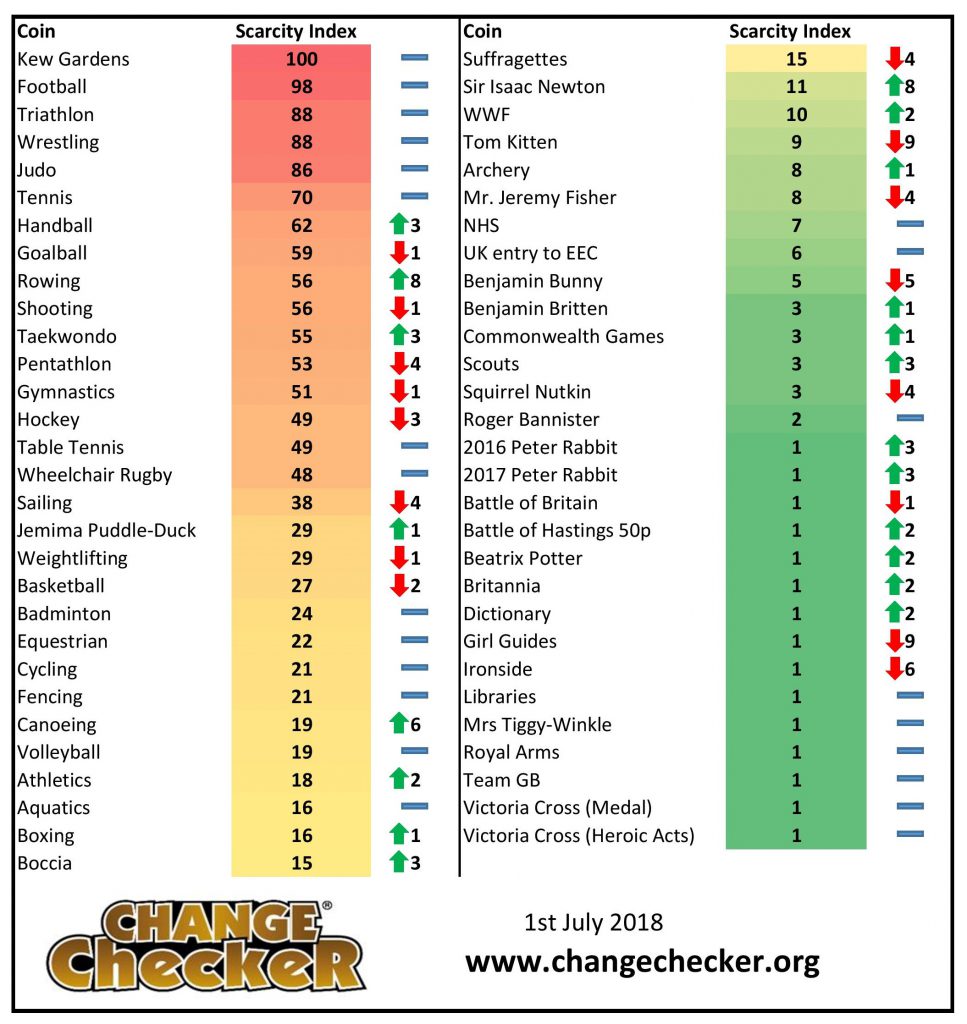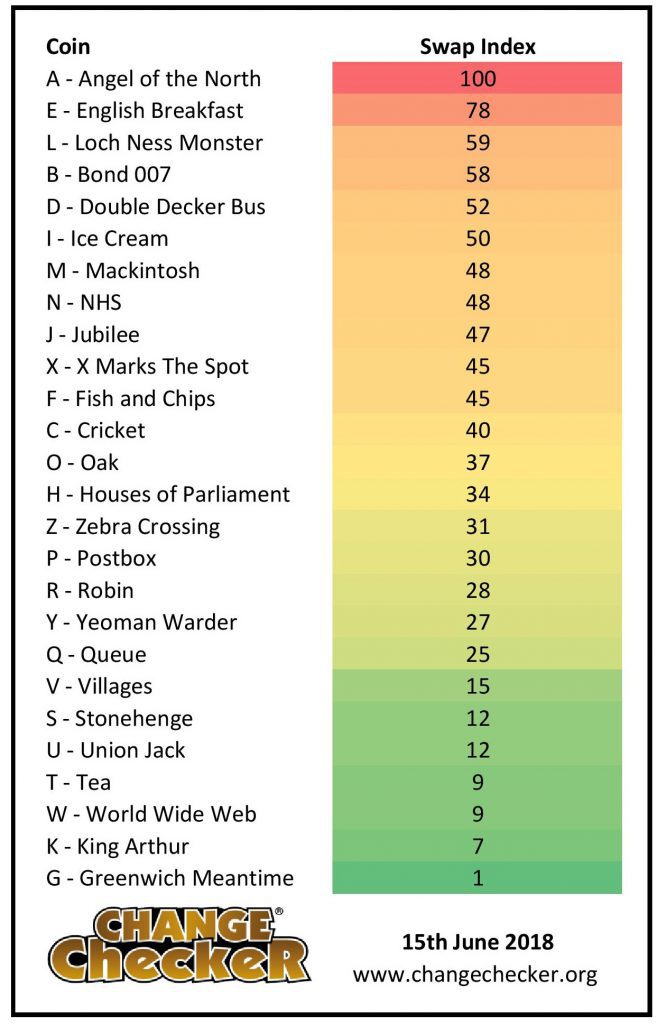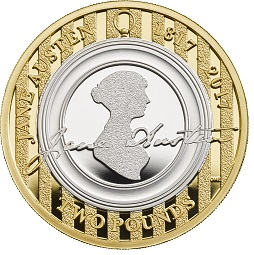Posts Tagged ‘Coin’
UPDATED: The results of our latest Scarcity Index are in…
The latest Change Checker Scarcity Index update of 2018 is here and the results are in…
The 50p and £2 Scarcity Indexes have been compiled using data from the second quarter of the year.
As per our previous quarter, you can now use our new feature to help you track the performance of your coins. The arrows signify how many places, up or down, a coin has moved on the Scarcity Index; any coins with a yellow star are making their first appearance after having been released into circulation.
50p Scarcity Index

Not surprisingly, Kew Gardens still remains the most scarce UK 50p coin with a mintage figure of just 210,000. There has been a lot of movement this quarter, with significant improvements in the performance of Sir Isaac Newton, Rowing and Canoeing.
On the other hand, both Girl Guides and Tom Kitten have seen less interest, with both coins moving 9 points down the Index.
Our top and bottom 6 coins seem to remain consistent for now, although there is always the potential for change as new coins enter circulation, and we’ve had a number of new releases recently that could mix things in up…
£2 Scarcity Index
Although the 2017 WW1 Aviation and Jane Austen £2 coins are yet to enter circulation, we’ve still seen some movement amongst the current coins in our Scarcity Index.
The ever popular Commonwealth Games Northern Ireland £2 regains its place at the top after a briefly being replaced by Wales. Another strong improvement goes to Trinity House, which has also moved up the Index 4 places.
On the other end of the spectrum, the Rugby World Cup and Florence Nightingale coins have moved down the Index this quarter, with Florence Nightingale dropping an impressive 8 places. This is due in part to a lack of Change Checkers requesting to swap these coins, however we wouldn’t be surprised to see these coins creeping up the Index in the next quarter.
What about the A to Z 10p coins?
Unfortunately, at present, there is simply not enough data to accurately compile a full A to Z 10p Scarcity Index. However, we have put together a ‘Swap Index’ using data from the Change Checker App which we feel is the most accurate way currently to determine which A-Z 10ps are most sought after.

Our top two coins (A for Angel of the North and E for English Breakfast) are very clearly the most sought after, with L for Loch Ness Monster coming in third. Speculation as to why people might be collecting certain designs is three pronged: 1) Perhaps people are looking for A to start their collection at the beginning of the alphabet. 2) They could be looking for coins that match their initials. 3) People might be collecting the coins based on which design/theme is their favourite.

Initially, a limited stock of 2.6 million A-Z 10p coins were released into circulation through the Post Office network to coincide with the release of the designs in March. It has been no surprise that these have been quickly snapped up by eagle-eyed change collectors.
As more coins enter circulation and are found, we will begin to see more data emerge and a full Index for these coins will be compiled.
How the Scarcity Index works
Generally collectors have had to rely upon mintage figures to identify the scarcest coins. But they only tell part of the story. Trying to find a good quality coin from 15 – 20 years ago, even for a higher mintage issue, is much more challenging than a more recent issue, as coins become damaged over time and are ultimately removed from circulation.
Additionally, some designs are more hoarded than others by people who might not normally collect coins – the recent poignant First World War £2 Coin series being an example. Finally, it can be up to a couple of years before the Royal Mint eventually confirms the actual mintage for an issue.
That’s why we have combined the mintage information with two other key pieces of information.
- How many of each design are listed as “collected” by Change Checkers, indicating the relative ease of finding a particular coin.
- The number of times a design has been requested as a swap over the previous 3 months, showing the current level of collector demand.
Importantly, as new coins are released and popularity rises and falls across different designs the Scarcity Index will be updated quarterly allowing Change Checkers to track the relative performance of the UK’s circulation coins.
How much are my coins worth?
The Scarcity Index does not necessarily equate to value but it is certainly an effective indicator. For example, the Kew Gardens 50p coin commands a premium of up to 160 times face value on eBay.
What about £1 Coins?
The £1 Scarcity Index has already been published for the Round £1 coins and, because they are no longer being issued, this is now set in stone.
If you’re interested in coin collecting, our Change Checker web app is completely free to use and allows users to:
– Find and identify the coins in their pocket
– Collect and track the coins they have
– Swap their spare coins with other Change Checkers

Sign up today at: www.changechecker.org/app
UPDATE: How rare is my coin? A Change Checker guide to UK coin mintages
You might remember our blog from last year reviewing 2016 coin mintages, but we’ve also updated our Change Checker Guide to UK coin mintages which includes all the details we have so far on the coins issued in 2017.
Have you managed to find any yet?

Updated mintages including 2017 dated 50p coins
Not surprisingly, Kew Gardens remains king of the 50p coins, with Jemima Puddle Duck also sitting in top three, however a new contender has knocked this sought-after Beatrix Potter 50p off second spot, as the 2017 Sir Isaac Newton 50p takes 2nd place just below Kew Gardens.
The 2017 Sir Isaac Newton 50p was issued to commemorate the achievements of one of the most influential scientists of all time and a key figure in the scientific revolution, as well as being master at The Royal Mint for three decades. Although this coin comes nowhere near to the Kew Gardens’ scarce mintage of 210,000 and is closer to Jemima Puddle Duck’s mintage of 2,100,000, still only 1,800,000 of these coins were minted, meaning our top three each have at least 1 million less coins in circulation than any other 50p.
Other newcomers to our updated UK mintage guide include the 2017 Beatrix Potter coins – Jeremy Fisher, Tom Kitten, Benjamin Bunny and Peter Rabbit. These four coins have fairly high mintage figures, with Peter Rabbit in fact having the highest mintage figure of all circulation 50ps at 19,300,000. This is thought to be due to the staggering popularity of the 2016 Beatrix Potter coins and high demand for the Peter Rabbit coin in particular. It will be incredibly interesting to see what the mintage figures for the 2018 Beatrix Potter characters will be.
But what about the 2017 £2 coins?
We haven’t been able to include the 2017 Jane Austen £2 or the WW1 Aviation £2 coins in our charts yet as the mintage figures are yet to be released, however you can view our previous £2 mintage figures here. There hasn’t been any feedback from Change Checkers finding these coins in circulation but we’re hoping they’ll turn up soon. We will of course be the first to update you as soon as we have more information on these coins.
So far in 2018, seven new 50ps have been released, including the Representation of the People Act, Peter Rabbit, Flopsy Bunny, Tailor of Gloucester, Mrs Tittlemouse, Paddington at the Station and Paddington at the Palace. As far as we’re aware the coins have not entered circulation and therefore we don’t expect the mintage figures to be released for quite a while.
Want to add the 2017 Jane Austen £2 to your collection?
Own it today in Brilliant Uncirculated quality. Secure yours here >>
Looking back at Britain’s much loved commemorative £2 coins…
The £2 coin was released in 1986, when this brand new denomination was introduced for the very first time.
The XIII Commonwealth Games was the first commemorative £2 coin and was issued for a non-royal event which gripped the nation. I can only imagine what an exciting time it must have been for people to discover these brand new coins which marked such a significant change in the UK’s commemorative coin issuing strategy.
These coins are considered rare due to the fact that although are legal tender, they were never common in everyday circulation and were struck mainly for collectors.
Six more single coloured £2 coins were struck over the next 10 years before the introduction of the fully circulating bi-metallic £2 denomination in 1998, which has seen 47 different designs in total so far.
So, let’s take a step back in time to 1986 and delve into the history of Britain’s commemorative £2 coins…
Commonwealth Games £2

Commonwealth Games. Mintage: 8,212,184. Years of issue: 1986
The 1986 Commonwealth Games £2 coin changed the face of UK commemorative coins, being the first of its denomination to be struck and the first British coin being issued to commemorate a sporting event. The thirteenth Commonwealth Games were held in Edinburgh in 1986, and are well remembered for being boycotted by 32 of the 59 eligible countries who did not agree with Britain’s sporting connections to South Africa during the Apartheid era. The reverse design features a thistle encircled by a laurel wreath over the cross of St Andrew.
Edge Inscription: XIII COMMONWEALTH GAMES SCOTLAND 1986
In 1689, Prince William and Mary accepted the Declaration of Rights prior to being offered the throne, which effectively shifted the balance of power from the Crown to Parliament and changed the course of British political history. These £2 coins were issued in 1989 to commemorate the 300th anniversary of this landmark Act. There were 2 versions of each coin issued – English and Scottish. The English reverse designs features the Crown of St Edward and the inscription ‘Tercentenary of the Claim of Right’ and ‘Tercentenary of the Bill of Rights’ respectively.
Bank of England £2

Bank of England. Mintage: 1,443,116. Years of issue: 1994
When William and Mary came to the throne in 1689, public finances were weak and the system of money and credit were in disarray. The Bank of England was founded in 1694 to act as the Government’s banker and debt manager, and its position as the centre of the UK’s financial system is maintained to this day. This commemorative £2 was issued in 1994 to mark its 300th anniversary. The reverse design features the original Corporate Seal of the Bank of England and distinctive Cypher of William and Mary.
Edge Inscriptions: SIC VOS NON VOBIS (thus you labour but not for yourselves)
Peace £2

Peace. Mintage: 4,394,566. Years of issue: 1995
This commemorative £2 was issued in 1995 to mark 50 years since the end of World War II. Victory in Europe Day, or VE Day, is the 8th May 1945 when armed forces formally accepted the surrender of Nazi Germany. Upon the news, jubilant crowds sang and danced in the streets of London, New York, Paris and Moscow. The reverse design by John Mills features a dove as “a symbol of aspiring peace; a calm, bountiful and optimistic image”.
Edge Inscriptions: 1945 IN PEACE GOODWILL 1995
United Nations £2

United Nations. Mintage: 1,668,575. Years of issue: 1995
The United Nations was established in the aftermath of World War II with the aim of maintaining world peace and to work for social progress. Since its creation in 1945, the UN has sought to resolve potential conflicts peacefully and fight against poverty, hunger and disease across the world. This commemorative £2 coin issued in 1995 marks 50 years since the inception of the UN, and features flags of nations accompanying the 50th anniversary symbol.
Football £2

Football. Mintage: 5,141,350. Years of issue: 1996
In 1996, England hosted the 10th European football championship and a commemorative £2 coin was struck in celebration of football. The reverse design resembles a football, and is accentuated by the unusual concave surface of the coin. The year of 1996 is prominent, and the sixteen small rings represent the sixteen teams competing in the tournament. The eventual winners of the competition were Germany who knocked out hosts England in the semi-finals.
Edge Inscriptions: TENTH EUROPEAN CHAMPIONSHIP
Following a review of the United Kingdom’s coinage, the decision was made that a general-circulation £2 coin was needed and so the new bi-metallic coin was introduced on the 15th June 1998.
As the first bi-metallic coin ever used in the UK, the £2 yet again revolutionised Britain’s coinage and changed the face of these incredibly popular coins, allowing them to be both commemorative and circulated, which has had a great impact for collectors who are able to find these coins in their change.
Do you have any of the above £2 coins?




